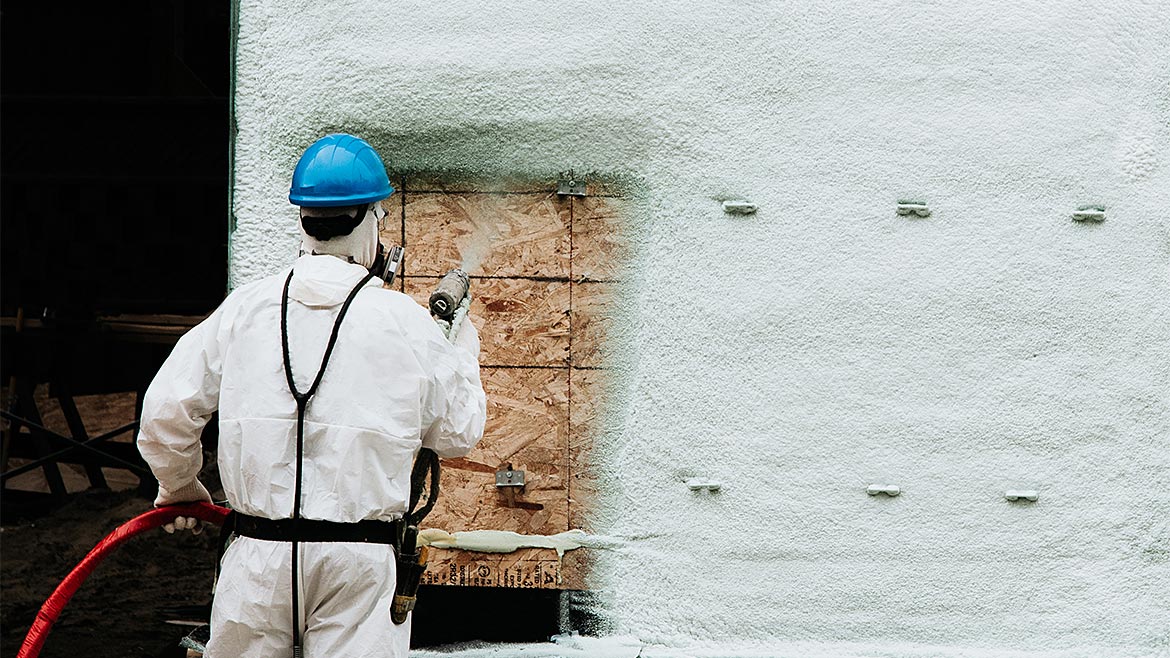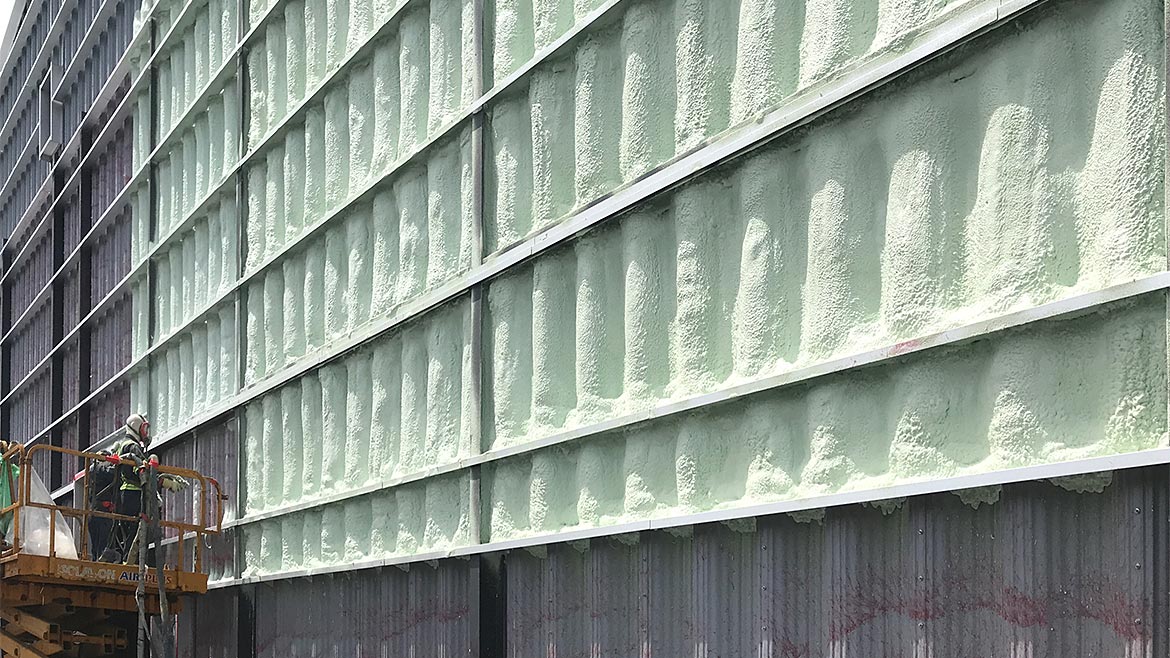Why Spray Foam? Efficiency, Energy Independence & Weather Resiliency

Spray polyurethane foam insulation is a high-performance building material used to optimize numerous types of structures, including office and retail properties, warehouse and industrial buildings, agricultural facilities, apartments, homes and more. The material is utilized in new construction and retrofits, and is professionally spray-applied. A sustainable solution maximizing energy efficiency, SPF insulation is often applied in ultra-high-performance facilities, such as net zero energy structures, as well as any number of other facilities, to lower energy bills and enhance indoor comfort. It is a useful tool for fortifying structures for weather resiliency and helping end users achieve energy independence.
Attributes, Uses & Performance
Spray foam insulation is unique in its ability to fulfill numerous functions in the building envelope, acting as a single-product solution for air, thermal and moisture control. This ability is meaningful in that it achieves more with a reduced number of products and labor requirements, likely contributing to the material’s growing popularity.
Spray foam insulation is offered in two core density classes: open-cell and closed-cell. Open-cell SPF is lower-density foam at approximately 0.5 to 1.4-pound density per cubic foot, with, as the name suggests, an open-cell structure. Closed-cell SPF is medium-density foam of approximately 1.5 to 2.3-pound density per cubic foot, with a closed-cell structure containing an insulating gas. Both densities of SPF insulation act as a thermal and air barrier, but each class of products offers different performance attributes, and those should always be considered when deciding which option to use in a structure.
Durability and versatility are cornerstones of spray foam insulation. A lightweight material, SPF insulation is also ideal for use in all climate zones. When applied, it vigorously adheres to the substrate and is notable for its characteristic in-place expansion without settling. Unlike many other insulation options, which may sag and lose R-value over time, SPF provides consistent performance for the life of the structure.

Energy Independence
As energy prices continue to surge and climate change wreaks havoc on the Earth with its resulting catastrophic weather events, more building owners, managers and tenants are looking for ways to increase their energy independence and reduce greenhouse gas emissions. Many companies now operate with corporate social responsibility measures designed to minimize their organization’s negative impacts on the Earth.
In addition to demand for renewable energy solutions, such as solar power and battery technology, these variables have led to increased requests among corporate end users for building envelope solutions that dramatically reduce heating- and cooling-related energy consumption within the structure.
Because of spray foam insulation’s unique ability to adhere seamlessly and tenaciously to the substrate, it eliminates cracks and gaps to create an airtight structure. With spray foam, the use of conventional electricity may be eliminated by up to 50 percent. When paired with solar power, spray foam is an even more powerful solution, creating a net zero (or even a net positive) energy structure that is independent of, or at the very least much less dependent on, the grid. Thus, not only are long-term energy cost savings optimized for companies operating in spray foam-insulated facilities, but these companies can increase their energy independence and are better able to meet corporate responsibility goals, including a reduced carbon footprint.

Decarbonization
Reducing the carbon footprint of individual companies and their facilities is important in the fight against climate change. Additionally, decarbonizing the country’s entire built environment, including all commercial facilities and homes, is crucial. A report by C2ES, or Climate Innovation 2050, identifies the commercial and residential buildings sector as one of the biggest contributors to greenhouse gas emissions. C2ES reports that fossil fuel combustion attributed to residential and commercial buildings accounts for roughly 29 percent of total U.S. greenhouse gas emissions.1
With spray foam’s ability to reduce energy consumption by up to 50 percent in buildings, insulating structures with the material is an extremely useful way to decarbonize our building stock and fight global warming.
Flood Resistance
Like residential homes, commercial facilities of all types are vulnerable to hurricanes and floods. First Street Foundation asserts that more than 14 million properties across the United States are susceptible to flood damage.2 Data like this points to the necessity for building and fortifying commercial properties with materials that will protect them from severe weather events. Closed-cell spray foam insulation is one such solution.
Ideal for use as continuous insulation, closed-cell spray foam can be used in both interior and exterior applications. The material provides both low water absorption and proven resistance to mold, as demonstrated per ASTM C1338. It performs as a water-resistive barrier on exterior applications and has been tested per ASTM E2357, with pressure up to 300 Pa for Air Barrier Assemblies, which included the ASTM E331 (AC71) Water Penetration Testing. The result was no leakage through the spray foam.
FEMA has named closed-cell SPF insulation a Class 5 material, its highest ranking for products, indicating a strong ability to resist floodwater damage. Class 5 materials do not require special waterproofing protection, can survive wetting and drying, and may be successfully cleaned after a flood to render them free of most harmful pollutants.3 Closed-cell SPF insulation may be applied as cavity insulation or as continuous insulation in commercial structures and, in these applications, qualifies as a Class 5 material. Notably, it is the only cavity insulation approved by FEMA with the highest floodwater resistance. Additionally, when applied under slab as insulation, closed-cell spray foam is also a vapor barrier.
References
- Center for Climate and Energy Solutions, C2ES, Climate Innovation 2050, Decarbonizing U.S. Buildings, 2018, https://www.c2es.org/site/assets/uploads/2018/06/innovation-buildings-background-brief-07-18.pdf
- First Street Foundation, The First National Flood Risk Assessment: Defining America’s Growing Risk, http://assets.firststreet.org/uploads/2020/06/first_street_foundation__first_national_flood_risk_assessment.pdf
- FEMA, Flood Damage-Resistant Materials Requirements for Buildings Located in Special Flood Hazard Areas in Accordance with the National Flood Insurance Program, Technical Bulletin 2, August 2008
Looking for a reprint of this article?
From high-res PDFs to custom plaques, order your copy today!









